Abstract
Shared autonomous vehicles (SAVs) are a major development direction in international scientific and technological innovation. One of the most popular features of SAVs in the urban space is that they can significantly reduce the need for parking. The urban underground parking space (UPS) is currently the largest static traffic space, especially in high-density urban centers. Under the SAV scenario, the need for the renewal of UPS will increase in the near future. However, renewal of the UPS is difficult due to its special form features, which are greatly restricted by the external environment, thus necessitating targeted methods and strategies. This research first conducted field investigations and data collection on the spatial morphology and service conditions of typical UPSs in different areas of Hangzhou city. Based on the driver status response and the multi-objective attribute models, the time-series evaluation method and function replacement decision model for the sustainable renewal of underground parking were established. The research also discusses appropriate design strategies for the combination of spatial characteristics and functional replacement goals of typical samples. The conclusions will provide scientific guidance for the future design practice of architects and urban designers in SAV.
1. Introduction
A city of shared autonomous vehicles (SAVs) is a major direction for international technological innovation. SAV technology liberates humans from commuting and brings incremental value to every public transportation user [1,2]. SAVs can reduce accident rates and alleviate traffic congestion; therefore, they are generally supported by governments of various countries. At present, the industry policy for SAVs is gradually improving, and various groups in society have good expectations for the environmental protections and convenience it offers. A series of latest studies from multiple countries [3,4,5,6,7,8] have shown that people of different genders, ages, professions, and education levels have different major concerns (e.g., affordability, security, and privacy) of SAVs. Although this may affect the adoption, the general attitudes of the public to SAVs are positive. Meanwhile, relevant cutting-edge technologies continue to make breakthroughs [9,10]. It is estimated that by around 2025, SAVs will account for a quarter of the total number of urban vehicles [11] (Figure 1). The emergence of SAVs will not only curb car ownership but also lead to a significant reduction in the demand for parking spaces in cities in the future because of the high operating rate of SAVs, the large degree of sharing, and the ability to park autonomously. Zhang and Guhathakurta [12] and Fagnant et al. [13] considered American cities as examples. Through simulation analysis, they found that the demand for urban parking spaces in different cities under the SAV scenario indicated considerable decline.
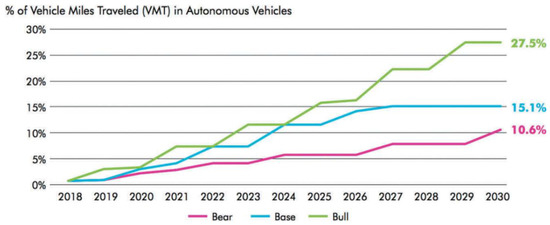
Figure 1.
Comparison of prediction of the popularization trend of SAV by different scholars or institutions (adapted from [11]).
Parking space accounts for a large proportion of urban built areas. The UPS is currently the largest type of parking space, especially in high-density urban areas [14]. It is widely distributed and large in scale, so the renewal of the UPS under the SAV scenario is of great significance to the sustainable development of cities [15,16]. However, owing to the particularity of the form of the UPS, its renewal is greatly affected by the above-ground buildings, surrounding environment, and other constraints. Therefore, it is generally more difficult to renew than above-ground structures [17]. Existing studies failed to establish corresponding renewal methods and strategies based on the characteristics of UPS, which will lead to a lack of scientific planning and guidance when renewing large amounts of UPSs. In fact, the renewal of fragmented space types such as UPSs has systemic characteristics and is diachronic in nature. Therefore, it is necessary to clarify the basic issues, including renewal time and goals, in order to propose a more reasonable design strategy [18]. Accordingly, the goal of this innovative study is to establish the timing evaluation and function replacement decision method of the UPS under the SAV scenario based on the principle of sustainability, and then propose corresponding design strategies. This research attempts to lay a theoretical foundation and provide scientific references for future digital urban renewal practices.
2. Literature
2.1. Parking Space Renewal in the SAV Scenario
There are various forms of parking spaces in cities, including roadside parking, open-air parking, parking buildings, and UPSs. The renovation of open-air parking lots and on-street parking spaces is relatively flexible and easy, while UPSs are currently only seen in a few cases [18]. The parking space is an urban system space, and its renewal process is diachronic and dynamic. Therefore, an important issue for the sustainable renewal of parking spaces is determining the development sequence of different parking spaces. Zhang [12] and Fagnant et al. [13] evaluated the urban parking demand at different time nodes under the SAV scenario and calculated the timing of the parking space update in different urban areas. For future smart parking spaces of SAVs, many researchers have discussed how to use intelligent algorithms to improve the parking density and space utilization of existing parking spaces [19,20,21].
Regarding the functional replacement of parking space renewal, Ziegenfuss [22] established an updated evaluation method to analyze public activities suitable for different types of ground parking lots and discussed the implementation methods of temporary reuse of open air parking spaces. At present, in most design practices of parking spaces, the possibility of future renovation and renovation is not considered. Albersman et al. [23] pointed out the main constraints and disadvantages of the renovation of parking garages, such as building space, structural loads, and equipment. They took parking buildings as an example to identify basic strategies for sustainable renewal. Simons and Kline [24] discussed the evolution trend of parking space under the SAV scenario and proposed a simple method for evaluating the sustainable renewal potential of parking buildings from the perspective of economic sustainability in order to determine the appropriate target function of the renovation.
2.2. The Possibilities and Benefits of Underground SPACE Renewal
At present, UPS renewal is mainly achieved through the adjustment of equipment and spatial configuration to improve the physical performance of the environment, such as improving thermal comfort [25], light environment [26], ventilation [27], fire protection [28], and energy consumption [29]. These cases were not concerned with the change in function as parking. However, in the SAV scenario, with the decline in parking demand, a large number of UPSs, especially in urban central areas, must consider the shift in functions [18].
Kasyanov and Oksana [30] revealed and determined the benefits of underground space renewal through investigation and analysis of underground space utilization in major cities around the world, for example, providing people with comfortable living and working conditions, increasing useful areas in urbanized areas without involving free land, stabilizing the area of large cities, improving the urban ecological environment, and increasing the greening of undeveloped areas. They also put forward ideas for the functional replacement of spatial renewal, including underground transportation facilities, industrial facilities, underground city networks, consumer service companies, special purpose buildings, trade, large-scale or sports complexes, and transportation pipelines. Xie et al. [31,32] analyzed the experience of international exploitation of underground space and systematically proposed nine functional types of underground space reuse: underground pumped storage power stations, deep underground medical and rehabilitation, underground storage, transportation, strategic energy resource reserves, underground data centers, domestic and industrial waste disposal, intelligent vertical parking systems, cutting-edge scientific facilities, underground agriculture, and underground ecological cities.
Compared with the renewal of above-ground space, underground space reconstruction is subject to structural constraints, involving higher standards of evacuation and fire protection requirements. UPSs also play a certain role in urban hazard avoidance. In this sense, UPS reconstruction is more difficult and requires targeted design methods and strategies. However, because UPSs are often located in areas with high land value, there is also great economic demand for reconstruction and reuse, which can improve urban vitality [33]. Moreover, the reuse of underground space is associated with low-carbon and sustainable urban development, which has led to increasing attention to this area of development. For example, Qian [15] and Hojjitaj [34] constructed evaluation methods for underground space renewal from the perspective of low carbon and sustainability. Admiraal & Cornaro [35] discussed the sustainable renewal goals, methods, and strategies of underground space in the context of climate change, resilient cities, and rapid urbanization based on worldwide case studies.
3. Methodology
3.1. Research Framework
The research first collects data on the spatial features and service conditions of UPSs through a field study. The samples were classified according to these attributes. Then, according to the driver status response (DSR) model and the AHP weighting method, a method for evaluating the timing sequence of UPSs under the SAV scenario is established to analyze the development timing sequence of different types of UPSs, and a library for function replacement is created according to expert opinions and literature research. The future function of each type of UPS is determined by a multi-objective attribute decision-making model. Finally, renewal strategies are discussed from the perspective of sustainability.
3.2. Research Area
China is striving to develop a new generation of artificial intelligence (AI) technology to accelerate SAV in practical applications [36]. Hangzhou is a large city on the east coast of China with a developed economy and high population density. Hangzhou has recently achieved strong, comprehensive strength in the fields of digitalization and AI. With leading companies such as Alibaba, it has built an urban brain management platform for smart cities and has become a pioneer city for innovative applications of AI. Acceptance of digital technology in Hangzhou is very high. Meanwhile, with high car ownership and insufficient parking space, the implementation of SAVs will have greater appeal [37]. For these reasons, the urban area of Hangzhou was selected as the investigation area.
3.3. Data Collection
Renewal of the UPS is directly related to factors such as its spatial composition, structural types, and functions of above-ground buildings. Moreover, the service conditions of UPSs in different areas of a city may differ. Therefore, in order to collect more comprehensive and diverse data, we conducted on-site investigations on UPSs in various urban areas of Hangzhou. The final sample data collected covers different types of representative areas in all the seven administration districts of Hangzhou, namely Shangcheng, Xihu, Gongshu, Yuhang, Qiantang, Binjiang, and Xiaoshan. The above-ground building functions include commercial retail buildings, corporate offices, hospitals, hotels, etc. Finally, 100 samples of UPSs in Hangzhou were obtained (Figure 2). In addition, their space composition was analyzed using diagrams (Figure 3).
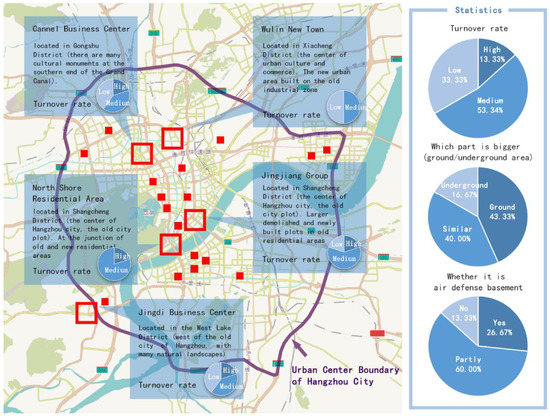
Figure 2.
The sample distribution in Hangzhou center.

Figure 3.
Analysis diagram of UPSs.
3.4. Clustering Analysis
According to the attributes of the UPS, different UPS categories were automatically formed by two-step clustering. The main differences between the categories were also revealed. The renewal time and function replacement of the different categories are discussed separately. The advantage of two-step clustering is that it can perform clustering based on categorical variables and continuous variables simultaneously and can automatically determine the final number of classifications. The clustering process is divided into two steps: first, the establishment of a cluster feature tree (cluster features) and second, the use of a merge clustering algorithm to combine the leaf nodes.
3.5. DSR Model
The DSR model is closely related to the environmental goals of sustainable urban development (e.g., reuse of built environment, sustainable urban space renewal, adaptable urban function organization [38,39]) and has strong management ideas [40]. According to the particularity of the UPS, this research improves the element composition of the existing DSR model. While reflecting the logical relationship between indicators, the revised model fully demonstrates the important role of stock space renewal in sustainable development. Among them, the “Drivers” (D) comes from the need for renewal of parking space from the external environment such as urban transformation; “Status” (S) is the current status of the architecture, landscape, underground space and ecological environment of the parking space, reflecting the redevelopment potential of the site itself; and “Response” (R) represents the attitude taken by the owners of the UPS towards redevelopment.
According to the degree of implementation, the research refines and determines the criteria, factors, and indicator levels related to the UPS renewal. Driver indicators include operating conditions (parking charge price, parking space turnover rate), the surrounding environment (location, function of ground building, mixture of function, and spatial connectivity), spatial structure (number of floors, scale of UPS, structural span, space height, and coverage of ground building), and functional attributes (i.e., whether it is a civil air defense basement). The response index is characterized by the type of UPS property owner. The specific meanings and nature of each indicator are listed in Table 1.

Table 1.
Indexes system of DSR Model.
According to the relevant national standards and the characteristics of the UPS, the evaluation level of each indicator is divided into two categories and one point or two points are assigned. The main reason for distinguishing only two categories is to simplify the calculation and facilitate two-step clustering. Research experts demonstrate the standards of the index evaluation, and, after repeated adjustments, determine the quantitative evaluation standards of each index. See Table 2 for further details. At the same time, based on the scoring results of experts, the AHP (Analytic Hierarchy Process) method is used to determine the index weights of drivers and status. Next, the consistency of the results is checked. The study uses the weighted sum method to evaluate the driving force and evaluate the state of the samples. This study uses the four-quadrant method to couple the driving force level and the state level evaluation results and divides the renewal potential into three categories from high to low, that is, high driving force with high status is recent development; high driving force with low status and low driving force with high status is medium-term development; and low driving force with low state is for long-term development.

Table 2.
Value assignments and weights of the DSR indexes.
3.6. Multi-Objectives Model
The function replacement selection of UPS is a typical multi-objective problem. Its characteristics are the incommensurability between the goals and the contradiction between the various attribute indicators. Decision makers analyze the existing decision data and sample information to comprehensively evaluate and rank the schemes of a limited number of UPSs to be replaced. Multi-objective attribute decision-making consists of two parts: alternatives and decision attributes. The decision-making process is expressed by the following formula:
where DR is the decision criterion; is the case of No. i; is the attribute of No. j; and is the utility function value of case i for attribute j. By Formula (2), according to the decision-making criteria, various UPS function alternatives can be compared and sorted. Different decision-making criteria and different utility function matrices result in corresponding multi-attribute decision-making methods. According to the general process of multi-objective and multi-attribute decision-making, the function replacement analysis of UPS involves six steps: (i) decision-making matrix establishment, (ii) recursive hierarchical structure, (iii) attribute value normalization, (iv) index weight determination, (v) calculation on comprehensive attribute utility value, and (vi) ranking of alternative scheme.
First, we establish an alternative library for UPS function replacement. According to the literature [30,31,33,41], current national regulations, industry design standards, and possible functions for future cities, the renewal function alternatives for urban UPS are organized and summarized in Table 3.

Table 3.
Library of replacement functions.
Then the research establishes corresponding attributes and weights according to different function goals, which are consistent with the DSR model. The weighting method uses the expert AHP method to obtain the calculation method for the suitability of the ten functional goals. After substituting the attribute values of different UPS cases, the best replacement target for each case is selected (Figure 4) by comparing the value sizes of all replacement functions. For example, the value of the functional target Commercial (F1) is calculated as follows:
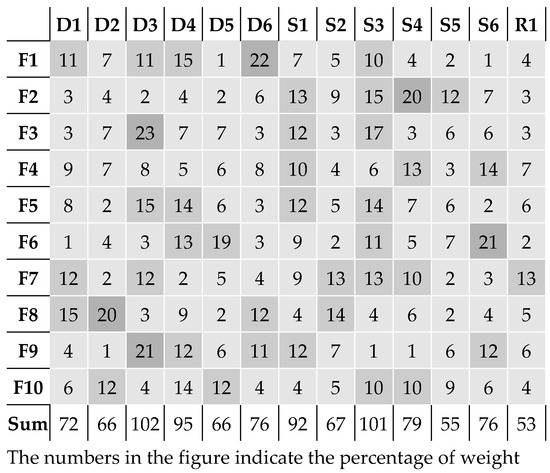
Figure 4.
Attribute weight matrix of function replacement multi-objective attribute decision-making model.
3.7. Statistics
The other statistical methods used in this study include the use of radar charts to compare the attributes of different types of UPSs, multiple regression methods to analyze the relationship between Divers indexes and Status indexes of different types of UPSs, correspondence analysis to find the relationship between renewal timing and related attributes of UPSs, and cross-tabs to compare the renewal timing of cases of different replaced functions.
4. Analysis
4.1. Type Features
For all 100 cases, the average of the 13 indicators was 1.52. For the six Driver indexes, the average value of 100 cases was 1.63 (D1), 1.42 (D2), 1.7 (D3), 1.52 (D4), 1.31 (D5), and 1.12 (D6), respectively. For the six Status indexes, the average values of all cases were 1.35 (S1), 1.51 (S2), 1.52 (S3), 1.66 (S4), 1.74 (S5), and 1.42 (S6), respectively. The average value of the response index was 1.87. The weighted average of the Drivers index was 1.48. The weighted average of the status indexes was 1.52.
According to 13 category variables, the two-step clustering method divides 100 cases into four categories. The variable ranking of classification importance is shown in Figure 5. The most important variables are the parking lot price, followed by geographic location, parking turnover rate, and floor height. The profile coefficient of classification quality was 0.25, which is acceptable, as indicated. These types have their own features. For example, there are 20 cases of the first type, for all of which the parking charges are less than or equal to 10 yuan/hour, for 55% of which the geographical locations are in the traffic node area, and for 75% of which the parking turnover rate is high. There are 25 cases of the second type, for 96% of which the parking charges are greater than 10 yuan/hour, for 92% of which the geographic locations are in traffic node areas, and for all of which the parking turnover rate is high or low. There are 37 cases in the third category, for 91.9% of which the parking charges are greater than 10 yuan/hour, for 89.2% of which the geographical locations are in traffic node areas, and for 62.2% of which have a low parking turnover rate. There are 18 cases in the fourth category, for 72.2% of which the parking charges are less than or equal to 10 yuan/hour, for 83.3% of which the geographical locations are in non-traffic node areas, and for 72.2% of which the parking turnover rate is high.

Figure 5.
Importance ranking of variables influencing the clustering.
The radar chart in Figure 6 shows the average values of the indicators of different UPS types. From Figure 6, it can be seen that the index values of D, S, and R of the four types are significantly different. The values of the D indexes of type 2 are more different than those of the other types while the value of S indexes of type 3 are relatively closer than other types. For the first type, the D, S, and R values are 1.31, 1.49, and 1.90, respectively; the D, S, and R values of the second type are 1.47, 1.39, and 1.92; the D, S, and R values of the third type are 1.59, 1.65, and 1.76, respectively; and the D, S, and R values of type four are 1.46, 1.50, and 2.00, respectively. It can be seen that the D and S of the third category are generally higher than those of the other types.
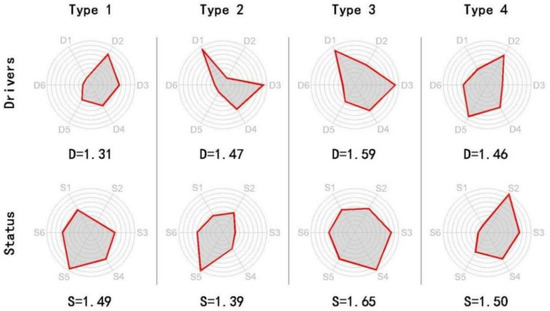
Figure 6.
Radar chart analysis on the attributes of UPS types.
4.2. Renewal Timing
According to Section 3.4, the following evaluation criteria of renewal timing are set: if a UPS meets D greater than 1.483 and S greater than 1.528, it will be considered as a case of recent development; if D is greater than 1.483 and S is less than 1.528, or D is less than 1.483 and S is greater than 1.528, it will be included in mid-term development; if D is less than 1.483 and S is less than 1.528, it will be seen as long-term development. According to this standard, the two-axis coordinate plane in Figure 7 is divided into four areas. The green area in the upper right corner is the recent development, the yellow areas in the upper left and lower right corners are the medium-term development, and the red area in the lower left corner is the long-term development. As can be seen from Figure 7, there are a total of 30 cases identified as recent development, of which 17 are type 3 and 7 are type 4; 46 cases are identified as medium-term development, of which 15 are type 3 and 13 are type 2; and 24 cases are identified as short-term development, including 9 cases of type 2 and 5 of type 1, 3, and 4. Nearly half of type 3 (45%) belong to recent development, more than one-third of type 2 (36%) belong to long-term development, and half of type 1, 2, and 3 are medium-term development. It can also be seen from Figure 7 that the D and S of different types have different relationships. For type 3, D and S have a weaker positive relationship, while D and S of other types have a weaker reverse relationship.
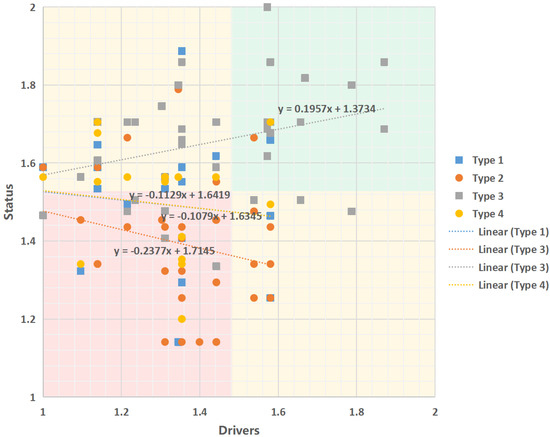
Figure 7.
Renewal timing evaluation.
This study conducts multiple correspondence analysis for renewal timing and the 13 indexes of the DSR model. The results are reflected in the correspondence analysis chart (Figure 8), which illustrates the correlation between the variables. Each scattered point in Figure 8 represents the level of a certain variable. The scattered points are close together if they have a closer level. According to the principle of interpretation of the corresponding analysis graph, it can be found that the variable characteristics of renewal timing belong to different quadrants in Figure 8. The characteristics of recent development and long-term development are far from the origin, indicating that their characteristics are significantly different. The main feature suitable for recent development cases is that the structure span is large and the upper building function is for public use; the main characteristics suitable for medium-term development are cases with no underground connection, a small ground floor area, and no other mixed functions; the main feature of long-term development cases is that the upper building is for civil use, with a small structural span and low storey height.

Figure 8.
Corresponding analysis of renewal timing and UPS attributes.
4.3. Function Replacement
According to the average value of 13 sustainable indicators for each case type, the weighting calculation and comparison of each replacement function for each case type are carried out based on the weight matrix, as shown in Figure 4. The results are listed in Table 4. Different types have different functional adaptabilities. For type 1, commercial function, schools, and libraries are more suitable; for type 2, schools, cultural entertainment, and commercial function are the most suitable replacement functions of all; for type 3, the most suitable functions are cultural entertainment, logistics, and libraries, whereas for type 4, the most suitable ones are data center, cultural entertainment, and libraries. In Table 4, the different types of suitable functions are sorted and the suitability of each function for different types is accumulated. It can be seen that the adaptability of the exhibition is the highest among all ten functions while the commercial function is the last choice.

Table 4.
Function replacement rankings for each UPS type.
We conducted a statistical analysis of the function replacement for 100 cases one by one, and obtained the renewal time distribution ratio of different function types. As shown in Figure 9, there are 23 cases whose suitable renewal function is exhibition while commercial and office are the least common functions (only four for each). The commercial, school, and library functions are all in the short-term or mid-term stages, and half of the office function is in the late stage; most of the commercial functions are in the short-term development stage. The largest and smallest proportion of mid-term renewal are libraries and data centers; most of the cases suitable for logistics centers and libraries are in the long-term development stage.
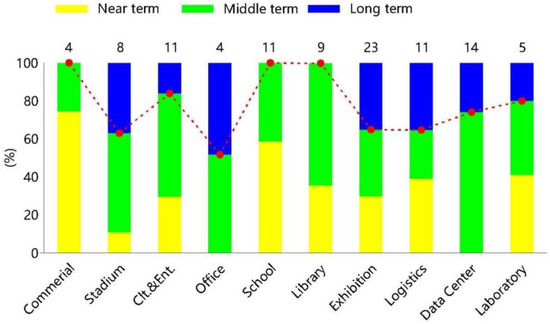
Figure 9.
Renewal time distribution ratio of different replacement functions.
5. Discussion
5.1. Renewal Strategies
The basic methods of sustainable design generally include passive and active strategies [42]. Passive strategies focused on using the architectural space itself to achieve natural ventilation and daylighting instead of equipment. Active strategies include various energy-saving and generation equipment, photovoltaic power generation, and geothermal energy utilization. This study analyzes the main problems to be solved in the spatial design according to the combination of the selected target function and the basic characteristics of each UPS type and then proposes appropriate renewal design strategies for each combination (Figure 10).
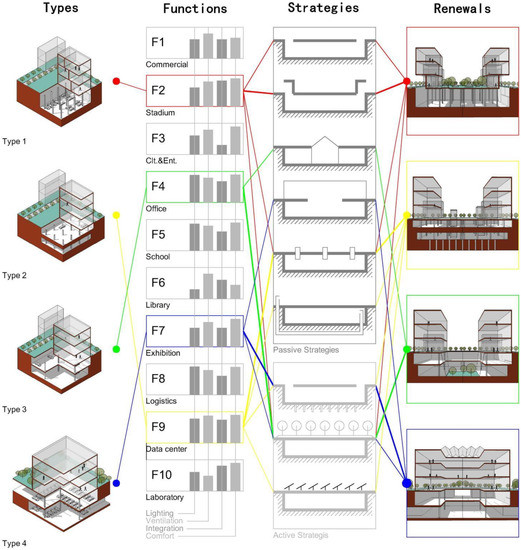
Figure 10.
Comparisons of renewal strategies for UPS types.
- Type 1 + Stadium
Sports venues need tall and complete spaces that have good natural ventilation, natural lighting, and safe evacuation measures. The single-storey, large-span, and high-space of type one is more in line with the needs of sports venues, but the general structural span and environment of the UPS cannot fully meet the standards of good sports venues. Therefore, further modifications in the space and structure are required.
In areas without upper building coverage, part of the structure can be removed to form a larger overall space that can satisfy the requirements of some large-scale ball games, such as basketball and football. The lighting and ventilation openings were designed on the roof of the newly added underground space, combined with ground cover and plant landscape, to improve the thermal performance of the envelope structure. At the same time, the first floor of the upper existing building can also be connected to the basement for large-space ventilation and lighting organization.
- 2.
- Type 2 + Data center
The data center consumes a lot of power and requires a constant temperature and humidity environment but has less space and structure requirements. The UPS of type two has a low space, dense column network, and high design load. It is the most suitable underground space for transformation into a data center. A multi-layer underground space has more advantages in terms of constant temperature and humidity than the above-ground space. However, environmental control needs to be further improved to meet the requirements of the data center.
For example, in a multi-layer underground environment, several vertical shaft spaces can be used for ventilation, dehumidification, and daylighting. Mechanical smoke prevention, exhaust facilities, and equipment should be added. In the part without an upper building, external vertical staircase entrance and exit need to be added. Of the active strategies, underground cold and heat pumps is a good choice for reducing space energy consumption.
- 3.
- Type 3 + Exhibition
The exhibition space needs a large and complete space that can be adjusted in various layouts and streamlines based on the content of the exhibition. Type three better meets these requirements and the multi-layered space can form a variable space combination to meet the artistic atmosphere and exhibition requirements. The temperature and humidity of the UPS have a protective effect on the exhibits.
The disadvantage is that the space below the basement level cannot provide good natural lighting. Therefore, the best reconstruction method is to dig an underground courtyard that connects with the ground space, which can better meet the lighting and ventilation requirements of the general exhibition space. Second, the underground courtyard also plays a very good role in improving the environmental quality of underground spaces. In a multistorey underground space, a partial hollowed-out floor slab design can be adopted to enhance the integrity of the space.
- 4.
- Type 4 + Logistics
Type 4 has better underground transportation connections and higher ground coverage that is more adaptable to logistics than other functions. Second, logistics and cargo sorting require large-scale equipment to enter and exit that generates a certain amount of noise. The upper building covering can better avoid these problems, and the upper building of Type 4 is for public use, which is also a good condition for the industrial use of UPS.
If possible, the renewal of this UPS type can be jointly transformed with the upper covering building to form an atrium space that penetrates the ground and underground to solve the problems of ventilation and lighting. This can also provide a visual connection for underground space management. The top of the atrium can be designed with a lighting guide to increase the collection of light in the basement.
5.2. Limitations of This Research
Because the scope and samples of this study are limited, and the index weight assignment and candidate function library are based on the subjective judgment of experts, this will lead to the subjectivity of the research conclusions. Second, although SAV is the trend of technological development in different countries and cities, development laws and their evolution differ, so the updated mode of UPS will also differ. Third, the renewal of urban space functions is affected by many factors. The functional replacement of the UPS as a construction can lead to hazardous engineering and geological processes, for example, a rise in the level of groundwater due to leaks or accidents [43]. In this paper, the engineering and geological conditions of UPS are not taken into account, as well as the reliability of structures in terms of responsibility and loads, which is directly related to the functional purpose of underground space [44,45,46]. Therefore, the functional adaptation of this research is only a reference from the architectural perspective. Fourth, it is impossible to predict new urban function types that will exist in the future. The organization of the renewal space in this study is based on existing experience and needs to be optimized over time.
5.3. Research Prospects
Despite these shortcomings, this research has important significance. It unearthed the new problems of spatial renewal in the transformation of digital cities and proposed feasibility analysis and problem-solving ideas, laying a theoretical foundation. Future research will be linked to low-carbon, ecology, and other goals, optimize the spatial form design with multiple objectives, and integrate it into design thinking in a more appropriate way so as to use scientific research to liberate the design process. In addition, future research will be based on the characteristics of urban systemic spaces and the digital city background, innovate more effective design methods, and carry out actual project demonstrations.
6. Conclusions
Based on the SAV scenario, this study conducted an exploratory study on the sustainable renewal methods and strategies of urban underground parking spaces. The following conclusions were drawn:
- The underground parking space with a large structural span and a public function of the upper building is suitable for early renewal while the cases with a small structural span and low storey height and the upper building for civil use are mainly appropriate for long-term development.
- The suitable replacement function of most cases is for the exhibition space function, and some cases are suitable for sports venues and training schools; the cases suitable for laboratories are mainly in the short and medium terms.
- For most underground parking spaces, the main contradiction of sustainable design lies in the lighting and ventilation of underground spaces. The use of recessed squares, lighting, and ventilation shafts can effectively solve design contradictions.
Author Contributions
Conceptualization, B.X.; methodology, B.X.; formal analysis, B.X., Y.F., H.S., J.S. and S.P.; investigation, Y.F., H.S. and J.S.; resources, B.X.; data curation, B.X., Y.F., H.S. and J.S.; writing—original draft preparation, B.X., Y.F., H.S., J.S. and S.P.; writing—review and editing, B.X.; visualization, B.X., Y.F., H.S., J.S. and S.P.; supervision, B.X.; project administration, B.X. and Y.F.; funding acquisition, B.X. All authors have read and agreed to the published version of the manuscript.
Funding
This research was funded by the Basic Public Welfare Research Program of Zhejiang Province (grant number: LGF21E080012), The Opening Fund of State Key Laboratory of Green Building in Western China (grant number: LSKF202003), Joint Funds of Zhejiang Provincial Natural Science Foundation of China (grant number: LHZ22F040001) and the National Natural Science Foundation of China (grant number: 51808486).
Data Availability Statement
The data presented in this study are available on request from the corresponding author. The data are not publicly available due to privacy.
Acknowledgments
Special thanks to the reviewers for their remarkable comments.
Conflicts of Interest
The authors declare no conflict of interest.
References
- Duarte, F.; Ratti, C. The impact of autonomous vehicles on cities: A review. J. Urban Technol. 2018, 25, 3–18. [Google Scholar] [CrossRef]
- Zakharenko, R. Self-driving cars will change cities. Reg. Sci. Urban Econ. 2016, 61, 26–37. [Google Scholar] [CrossRef]
- Launonen, P.; Salonen, A.O.; Liimatainen, H. Icy roads and urban environments. Passenger experiences in autonomous vehicles in Finland. Transp. Res. F-Traf. 2021, 80, 34–48. [Google Scholar] [CrossRef]
- Christophe, O.; Schneble, D.M. Shaw, Driver’s views on driverless vehicles: Public perspectives on defining and using autonomous cars. Transp. Res. Interdiscip. Perspect. 2021, 11, 100446. [Google Scholar]
- Morita, T.; Managi, S. Autonomous vehicles: Willingness to pay and the social dilemma. Transp. Res. C-Emer. 2020, 119, 102748. [Google Scholar] [CrossRef]
- Hilgarter, K.; Peter Granig, P. Public perception of autonomous vehicles: A qualitative study based on interviews after riding an autonomous shuttle. Transp. Res. F-Traf. 2020, 72, 226–243. [Google Scholar] [CrossRef]
- Kaltenhäuser, B.; Werdich, K.; Dandl, F.; Bogenberger, K. Market development of autonomous driving in Germany. Transp. Res. A-Pol. 2020, 132, 882–910. [Google Scholar] [CrossRef]
- Tian, Z.; Feng, T.; Timmermans, H.J.P.; Yao, B. Using autonomous vehicles or shared cars? Results of a stated choice experiment. Transp. Res. C-Emer. 2021, 128, 103117. [Google Scholar] [CrossRef]
- Silva, D.; Foldes, D.; Csiszar, C. Autonomous vehicle use and urban space transformation: A scenario building and analysing method. Sustainability 2021, 13, 3008. [Google Scholar] [CrossRef]
- Parkin, J.; Clark, B.; Clayton, W.; Ricci, M.; Parkhurst, G. Autonomous vehicle interactions in the urban street environment: A research agenda. Proc. Inst. Civ. Eng.-Munic. Eng. 2018, 171, 5–25. [Google Scholar] [CrossRef]
- Simons, R.A.; Marlkin, A.A. The Forward-looking Adoption Timeline for Driverless Cars and Corporate Owned Fleets. In Driverless Cars, Urban Parking and Land Use; Simons, R.A., Ed.; Routledge: New York, NY, USA, 2020; pp. 153–173. [Google Scholar]
- Zhang, W.; Guhathakurta, S. Parking spaces in the age of shared autonomous vehicles: How much parking will we need and where? Transp. Res. Rec. 2017, 2651, 80–91. [Google Scholar] [CrossRef]
- Fagnant, D.J.; Kockelman, K.; Bansal, P. Operations of a shared autonomous vehicle fleet 2 for the Austin, Texas, market. Transp. Res. Rec. 2019, 2563, 98–106. [Google Scholar] [CrossRef] [Green Version]
- Zhang, Z.L.; Zhang, P. Planning and Design of Urban Underground Parking System; Southeast University Press: Nanjing, China, 2014. [Google Scholar]
- Qian, Q.H. Low-Carbon Design and Evaluation of Urban Underground Space; Tongji University Press: Shanghai, China, 2015. [Google Scholar]
- Qiao, Y.K.; Peng, F.L. Low carbon effects of urban underground space. Sustain. Cities Soc. 2019, 45, 451–459. [Google Scholar] [CrossRef]
- Golany, G.S. Geo-Space Urban Design; Wiley: London, UK, 1996. [Google Scholar]
- Xia, B.; Wu, J.; Wang, J.; Fang, Y.; Shen, H.; Shen, J. Sustainable Renewal Methods of Urban Public Parking Spaces under the Scenario of Shared Autonomous Vehicles (SAV): A Review and a Proposal. Sustainability 2021, 13, 3629. [Google Scholar] [CrossRef]
- Estepa, R.; Estepa, A.; Wideberg, J.; Jonasson, M.; Stensson-Trigell, A. More Effective Use of Urban Space by Autonomous Double Parking. J. Adv. Transp. 2017, 2017, 8426946. [Google Scholar] [CrossRef] [Green Version]
- Azevedo, J.; D’orey, P.M.; Ferreira, M. High-Density Parking for Automated Vehicles: A Complete Evaluation of Coordination Mechanisms. IEEE Access 2020, 8, 43944–43955. [Google Scholar] [CrossRef]
- Siddique, P.J.; Gue, K.R.; Usher, J.S. Puzzle-based parking. Transp. Res. C-Emer. 2021, 127, 103112. [Google Scholar] [CrossRef]
- Ziegenfuss, K. Constructing Use in Surface Parking Lots: Strategies for Enhancing Lots as Part-Time Public Spaces. Master’s Thesis, MIT, Cambridge, MA, USA, 2009. [Google Scholar]
- Albersman, D.; Leedom, C.; Pandya, S. Adaptive reuse of parking structures. In A Guide to Parking; International Parking Institute; Routledge: New York, NY, USA, 2018; pp. 152–156. [Google Scholar]
- Simons, R.A.; Kline, J. Urban adaptive reuse potential from the architect’s perspective. In Driverless Cars, Urban Parking and Land Use; Simons, R.A., Ed.; Routledge: New York, NY, USA, 2020; pp. 190–233. [Google Scholar]
- Yang, X.; Zhao, Z.; Hua, R.; Su, X.; Mac, L.; Chen, Z. Simulation study on the influence of urban underground parking development on underlying surface and urban local thermal environment. Tunn. Undergr. Space Technol. 2019, 89, 133–150. [Google Scholar] [CrossRef]
- Song, D.; Lv, H.; Liao, J.; Huang, W.; Huang, S.; Cheng, C.; Zhou, H.; Su, Y.; Riffat, S. Evaluation of a large dish-type concentrator solar lighting system for underground car park. Int. J. Energ. Res. 2018, 42, 2234–2245. [Google Scholar] [CrossRef]
- Cho, J.; Kim, J.; Park, W.; Kim, Y. A step-by-step numerical method for optimization of mechanical ventilation in deep underground enclosed parking lots: A case-design study. J. Build. Eng. 2021, 42, 102799. [Google Scholar] [CrossRef]
- Tharima, A.F.; Rahman, M.M.; Yusoff, M.Z.; Kueh, A.B.H. Multi-objective optimization of underground car park design for tenability under fire-induced smoke. Tunn. Undergr. Space Technol. 2019, 85, 220–230. [Google Scholar] [CrossRef]
- Lautkankare, R.; Salomaa, N.; Martinkauppi, B.; Slobodenyuk, A. Underground parking lot at Turku market square—Zero energy parking hall and the biggest solar energy storage in the world. In Proceedings of the 2020|12th Nordic Symposium on Building Physics (NSB 2020) 172, Tallinn, Estonia, 6–9 September 2020. [Google Scholar]
- Kasyanov, V.; Oksana, C. Use of Underground Space in Large Cities. In Proceedings of the 3rd World Multidisciplinary Civil Engineering, Architecture, Urban Planning Symposium (WMCAUS)|3RD World Multidisciplinary Civil Engineering, Architecture, Urban Planning Symposium (WMCAUS 2018) 471, Prague, Czech Republic, 18–22 June 2018. [Google Scholar]
- Xie, H.; Zhao, J.W.; Zhang, R.X. Secondary utilizations and perspectives of mined underground space. Tunn. Undergr. Space Technol. 2020, 96, 103129. [Google Scholar] [CrossRef]
- Xie, H.; Zhang, Y.; Chen, Y.; Peng, Q.; Liao, Z.; Zhu, J. A case study of development and utilization of urban underground space in Shenzhen and the Guangdong-Hong Kong-Macao Greater Bay Area. Tunn. Undergr. Space Technol. 2021, 107, 103651. [Google Scholar] [CrossRef]
- Chen, Z.L.; Chen, J.Y.; Zhang, Z.F. Present status and development trends of underground space in Chinese cities: Evaluation and analysis. Tunn. Undergr. Space Technol. 2018, 71, 253–270. [Google Scholar] [CrossRef]
- Hojjati, A.; Jefferson, I.; Rogers, C.D.F. Embedding sustainability criteria into pre-appraisal of underground utility for future cities. Proc. Inst. Civ. Eng.-Urban Des. Plan. 2020, 170, 258–271. [Google Scholar] [CrossRef] [Green Version]
- Admiraal, H.; Cornaro, A. Underground Spaces Unveiled: Planning and Creating The Cities of The Future; Ice Publishing: London, UK, 2021. [Google Scholar]
- State Council of the People’s Republic of China. New Generation Artificial Intelligence Development Plan; State Council of the People’s Republic of China: Beijing, 2017. Available online: http://www.gov.cn/zhengce/content/2017-07/20/content_5211996.htm (accessed on 20 December 2021).
- Zheng, Z.X. Hangzhou City: Innovation empowers the city, “number” and “wisdom” share the future. China City News, 28 June 2021. [Google Scholar]
- Xu, S.; Cheng, Q. Evaluation system of sustainable development of industrial relocation area based on DSR model: A case study of Tiexi old industrial relocation area, Liaoning Province, China. J. Shenyang Univ. 2021, 33, 220–228. [Google Scholar]
- Zhang, M.; Chen, Y.; Zhou, H. Evaluation for the low-carbon and intensive urban land use based on the DSR model—A case study of Wuhan city. Res. Soil Water Conserv. 2015, 22, 169–175. [Google Scholar]
- Li, X.; Yang, H.; Liu, L. Evaluation system for prioritization tool to redevelop abandoned coal mine industry square based on DSR model. Trans. Chin. Soc. Agric. Eng. 2018, 34, 224–231. [Google Scholar]
- Cui, J.Q.; Broere, W.; Lin, D. Underground space utilisation for urban renewal. Tunn. Undergr. Space Technol. 2021, 108, 103726. [Google Scholar] [CrossRef]
- Lechner, N.M.; Andrasik, P. Heating, Cooling, Lighting: Sustainable Design Strategies towards Net Zero Architecture, 5th ed.; Wiley: New York, NY, USA, 2021. [Google Scholar]
- Yun, B. Underground Engineering: Planning, Design, Construction and Operation of the Underground Space; Academic Press: Cambridge, MA, USA, 2018. [Google Scholar]
- Pei, C.; He, X.; Cao, L.; Zhu, J.; Liao, M.; Guo, H. Geological problems and economic evaluation for underground space utilization. Proc. Inst. Civ. Eng.-Urban Des. Plan. 2021, 174, 63–75. [Google Scholar] [CrossRef]
- Dou, F.F.; Li, X.H.; Xing, H.X.; Yuan, F.; Ge, W.Y. 3D geological suitability evaluation for urban underground space development—A case study of Qianjiang Newtown in Hangzhou, Eastern China. Tunn. Undergr. Space Technol. 2021, 115, 104052. [Google Scholar] [CrossRef]
- Cui, C.; Wang, B.; Zhao, Y.; Xue, L. Waste mine to emerging wealth: Innovative solutions for abandoned underground coal mine reutilization on a waste management level. J. Clean Prod. 2020, 252, 119748. [Google Scholar] [CrossRef]
Publisher’s Note: MDPI stays neutral with regard to jurisdictional claims in published maps and institutional affiliations. |
© 2021 by the authors. Licensee MDPI, Basel, Switzerland. This article is an open access article distributed under the terms and conditions of the Creative Commons Attribution (CC BY) license (https://creativecommons.org/licenses/by/4.0/).